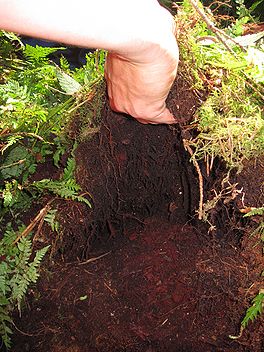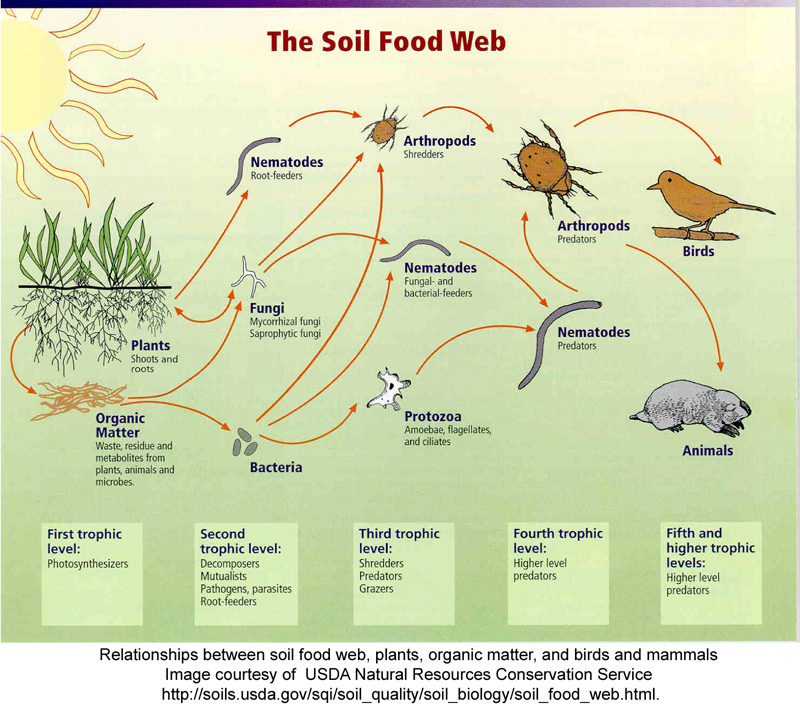LFS:SoilWeb/Soil Biology/Soil Organisms
| SoilWeb Learning Resource | |
|---|---|

| |
| Land and Food Systems | |
| Welcome to the wiki for SoilWeb200. The SoilWeb200 learning resource provides students with text, graphical and interactive web-based information to assist them in learning the connections among a large number of concepts and to relate them to various soil management issues as presented in the course APBI 200 - Introduction to Soil Science. | |
| Associated Pages | |
The soil is a complex ecosystem with a diverse community of organisms. They interact with each other through a complex network of energy and nutrient transfers known as a food web.
The soil food web is composed of the community of organisms that live all or part of their lives in the soil. It describes a complex living system with interactions between the abiotic environment, plants, and animals. A food web describes the transfer of energy between species in an ecosystem. While a food chain examines one, linear, energy pathway through an ecosystem, a food web is more complex and illustrates all of the potential pathways. Much of this transferred energy comes from the sun. Plants use the sun’s energy to convert inorganic compounds into energy-rich, organic compounds, turning carbon dioxide and minerals into plant material by photosynthesis.

Soil organisms are creatures that spend all or part of their lives in the soil. There are several criteria that can be used to classify soil organisms. For example, soil organisms are classified according to their size into:
- Macro-organisms (> 2 mm in width),
- Meso-organisms (0.2 to 2 mm in width), and
- Micro-organisms (< 0.2 mm in width).
Based on the ecological functions that soil organisms perform, they can be classified as:
- Herbivores that subsist on living plants
- Detritivores that subsist on dead plant debris
- Predators that consume animals
- Fungivores that eat fungi
- Bacterivores that eat bacteria
- Parasites that live off, but do not consume, other organisms
Another classification of soil organisms groups them into:
- Heterotrophs that rely on organic compounds for their C and energy needs, and
- Autotrophs that obtain their C mainly from CO2 and their energy from photosynthesis or oxidation of various elements.
Most Common Groups of Organisms
Higher plants provide a large quantity of organic residue to the soil through roots and litterfall. Roots consume oxygen, water and nutrients, while releasing CO2 and exudates (mixture of organic acids, sugars and other soluble plant compounds that escape from roots). Roots influence microbial activities especially in the rhizosphere.
Algae belong to soil microflora. They are autotrophic (i.e., have chlorophyll and are capable of performing photosynthesis) and eukaryotic organisms. Algae are most active and abundant in wet soils. In dry soil, the water film that surrounds soil particles becomes too thin for them to move freely. Because they need light for photosynthesis, algae are most common at or very near the soil surface. Some algae make symbiotic associations with fungi forming lichens that are important in colonizing bare rocks and other low-organic-matter environments (deserts). The most common groups of algae present in soil are:
- green,
- yellow-green, and
- diatoms.
In addition to producing a substantial amount of organic matter in some fertile soils, certain algae excrete polysaccharides that have very favourable effects on soil aggregation.
Fungi belong to soil microflora (heterotrophic, aerobic) and are eukaryotic organisms. As heterotrophs, fungi depend on living or dead organic materials for both their C and energy. They may be divided in the following three groups:
- yeasts - single-celled organisms that live in waterlogged, anaerobic soils,
- molds, and
- mushroom fungi.
Fungi play an important role in the decomposition of various organic substances (cellulose, hemicellulose, lignin), they may form symbiotic relationships with plants (mycorrhizae) or act as pathogens, and they play a major role in humus formation and aggregate stabilization.
You Didn’t Know Mushrooms Could Do All This by National Geographic www.youtube.com/watch?v=BlcKBKJ8uro
Actinomycetes belong to soil microflora (heterotrophs, aerobic). They are single-celled, prokaryotic, filamentous and often profoundly branched organisms. They are of great importance in the decomposition of soil organic matter and the mineralization of nutrients, especially in alkaline soils. Many actinomycetes produce antibiotic compounds that kill other microorganisms (e.g. streptomycin is produced by growing soil actinomycetes in pure culture).
Bacteria belong to the Kingdom Monera, can be either autotrophic or heterotrophic, and can be both aerobic and anaerobic. They are single-celled, prokaryotic organisms and are the most diverse group of soil organisms. A gram of soil may contain 20,000 different species. They have evolved mechanisms to adapt to life in the most extreme of environments. Due to their diversity they play many roles in the soil and are involved in all of the organic transactions. Their most important role is in decomposition of dead organic matter and mineralization of nutrients such as N and S to forms available to plants. Another critical process in which bacteria are prominent is N-fixation.

Cyanobacteria (formerly called blue-green algae) belong to soil microflora and are either autotrophic or heterotrophic. They are also prokaryotic and among the most ancient of organisms. Many genera of cyanobacteria can fix atmospheric N (e.g., Anabaena sp.)and are especially plentiful in rice paddies and other wetland soils, where they fix large quantities of N.
Soil animals often account for only a small fraction of the total breakdown of organic matter, which is mostly due to microbes. However, they have a strong influence on the rate of organic matter breakdown, because their chewing and shredding activity divide organic matter into smaller particles, which increases the surface area exposed to microbial attack.
Vertebrates (mice, moles, ground squirrels, etc.) are an example of soil macrofauna. They mix soil through their burrowing activity and contribute to the formation of an Ah horizon.
Annelida (segmented worms) are another example of soil macrofauna. They are decomposers (detritivores). The most important species of Annelida are earthworms (especially those from genera Lumbricus). Earthworms are the original tillers of soil and can thus improve the rooting environment for plants and increase the amount of water that infiltrates the soil. Earthworms mix soil and organic matter and leave casts (their wastes) in the soil to become soil aggregates.
RELATED LINK:
|
Arthropods are fauna with a jointed exoskeleton and can belong to the macro or meso group. They are a diverse group of bizarrely shaped spiders, mites, pseudoscorpions, and insects. Many arthropods prey on disease-causing pests. Others help to shape soil structure and thus can improve root development, water infiltration, drainage, and aeration. Some arthropods are the front line in decomposition of organic matter. They shred plant residues, mix them with soil, and stimulate decomposition within their intestines. They are especially important in forests, rangelands, no-till cropland, and in other areas where the soil is minimally disturbed and covered all year.

Protozoa belong to soil microfauna. All protozoans are heterotrophic, and usually obtain their food through some form of ingestion followed by intracellular digestion. They are either bacterivores or fungivores. A few are capable of alternating between a heterotrophic and autotrophic mode of nutrition, depending upon the resources available. Finally, some are internal or external parasites of animals. Some species actively prey on live bacteria, whose population they control. They are commonly found near roots and other places where bacteria congregate. Typically when bacterial populations increase (e.g., following rainfall) protozoan populations also increase. Because protozoa have lower N requirements than many bacteria, they excrete excess N obtained from the consumption of bacteria as ammonia (inorganic N). Hence protozoa, (together with nematodes) are important in enhancing mineralization in soil by releasing the N taken up by bacteria.
The subdivision of this group into different phyla is based on how they feed and move. The general trend in the taxonomy is to distinguish between those
- that move by "cilia" ciliates (the largest soil protozoa),
- flagellates (move by flagellum), and
- amoebas (move by pseudopodia).
Considerable numbers of animal and human diseases are attributed to infection by protozoa, but mainly by those that are water borne, rather than soil borne.
Nematodes (commonly known as threadworms or roundworms) belong to soil microfauna. They are found in almost all soils in surprisingly large numbers. Some are plant parasites that infest roots, some are predators that feed on other nematodes or bacteria, fungi, and protozoa. Like protozoa, nematodes have lower N requirements than many bacteria. Soil compaction generally reduces the populations of nematodes, which need adequate space between soil aggregates to move around.

RELATED LINK:
|